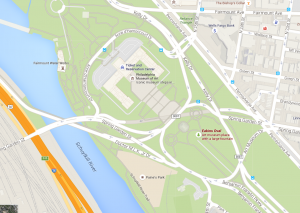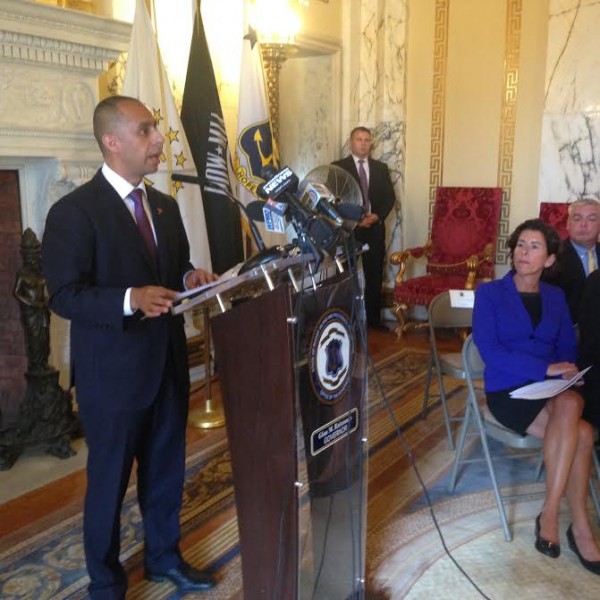 Please join me in giving a round of applause to Mayor Elorza and the Providence Department of Planning and Development for their hard work and due diligence every step of the way during the 6/10 Connector’s community engagement process.
Please join me in giving a round of applause to Mayor Elorza and the Providence Department of Planning and Development for their hard work and due diligence every step of the way during the 6/10 Connector’s community engagement process.
The city has been extremely transparent and open, taking the public’s input into consideration while drafting their design for the future of the 6/10 Connector. It is reassuring to know that the mayor and the planning department are actively listening to the needs and wants of the community. By taking a bottom-up approach, the City of Providence is conveying that its interests align with that of its communities, and appreciates the ideas and solutions that its residents bring to the table. Who else knows what’s best for the City of Providence other than the residents that live, work, and thrive here.
On Monday, October 3, the City released their draft plans for the future of the 6/10 Corridor at a public forum held at the Doorley Jr. Municipal Building in downtown Providence. While the City’s plans do not call for a surface boulevard that I and other community members would have liked to see presented, I can tolerate the parkway design. The parkway concept addresses the concerns of both sides about the looming question, “What should the future of the 6/10 Connector look like?” The plan addresses the need to fast-track the reconstruction of the structurally deficient Huntington Viaduct, out of concern that the structure might collapse. The plan appeases auto-interests as well as those citizens who want to see a concept that is more pedestrian and bike friendly, although we would much prefer a pure boulevard instead of a parkway.
The proposed parkway plan frees up land for development (approximately 50 acres), expands the footprint of DePasquale Square, adds two new off-street bike paths, creates a new exit to West Exchange Street, adds additional connections to the existing street grid, and reconnects parts of Olneyville to the urban fabric of Providence, among other things as well. The proposed “halo” elevated rotary where Route 6 merges with Route 10 allows for the potential to incorporate boulevard elements into sections of the route further down the line. While the entire length of the 6/10 Connector isn’t the pure boulevard that many of us had envisioned, the two-phased parkway plan allows the City and State to revisit the compelling arguments made in favor of an intermodal boulevard.
The most important aspect of the plan isn’t the plan itself. Rather, it is culmination of everything that has led to the plan being drafted in the first place. It is the countless hours spent by engaged citizens, who took it upon themselves to get involved, speak out, and voice their opinions about the project; citizens who persevered even when things weren’t going their way because they knew that this is a critical, once-in-a-lifetime opportunity to turn the 6/10 Connector into something truly special. Without vocal citizens and lots of vigorous discussions, RIDOT would probably have elected to refurbish the highway a long time ago, and that wouldn’t have worked for motorists, bicyclists, pedestrians, and city residents alike.
The future of the 6/10 Connector will single-handedly change the physical, social, and economic makeup of the city for generations to come. It is up to us as citizens to decide whether or not we want to make Providence a more livable community for our children, our children’s children, and ourselves. Or, if we want to sit idle, content with the current economic conditions in our Capital City. The choice is ours. RIDOT has the final say about the project’s design, and I strongly encourage my fellow Rhode Islanders to continue to be actively involved in the process, and vocal about the future we envision for a livable, thriving city for decades to come.
]]>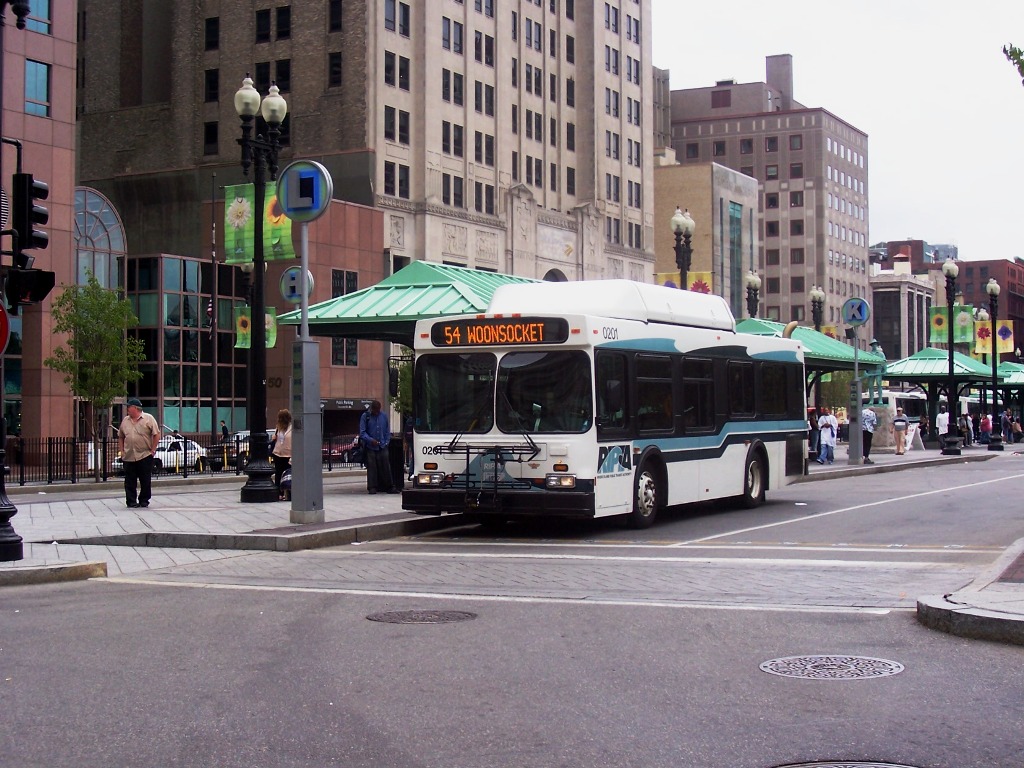 Have you heard about the $17 million “Downtown Enhanced Transit Corridor” grant that the city of Providence received for the Rhode Island Public Transit Authority to develop a 6-stop enhanced bus corridor to run from the Providence Railroad station to a new bus hub in the hospital district? Its largely the route originally planned to be for a streetcar.
Have you heard about the $17 million “Downtown Enhanced Transit Corridor” grant that the city of Providence received for the Rhode Island Public Transit Authority to develop a 6-stop enhanced bus corridor to run from the Providence Railroad station to a new bus hub in the hospital district? Its largely the route originally planned to be for a streetcar.
RIPTA is organizing a “stakeholder” group to advise on implementation, the first meeting of which is scheduled for October 24. The RIPTA Riders Alliance, of which I am a member, was invited to participate. An open public meeting for all may be scheduled later.
$17 million should be enough to be a potential game-changer for downtown and for RIPTA, both of which are struggling. Indeed RIPTA ridership has dropped significantly in the last 2 years, from about 20 to 18 million riders. Not long ago the RIDOT Director publicly called RIPTA a “failure” because of our low commute by transit rate. The decision by Citizens Bank to locate a huge corporate “campus” west of I-295 where there is no transit is an indication of how little RIPTA can matter to employers. Downtown is hurting too, from the long empty “Superman” building to the well publicized perception of unpleasant conditions and “chaos” in Kennedy Plaza.
RIPTA planners have said they intend to use the $17 million grant to jazz up the bus stops with enhanced amenities, to buy some ultra-clean hybrid buses, and have six of their lines (#1,3,6,51,58,72) routed on the
corridor to ensure very frequent service.
While this includes some good ideas, at $2/ride, soon likely to be $2.50, I don’t see how this will attract many new riders who don’t already have a pass or ride free anyway. I don’t see how this expensive fare will do much to attract attention of those wanting to do business that might lead to economic redevelopment. Thus I suggest that the buses RIPTA wants to buy be used to establish a free loop on that corridor.
About a year ago the Coalition for Transportation Choices hosted a meeting here with invited speakers from Denver, Minneapolis and Hartford where transit initiatives were successful in building ridership and spurring economic development. One thing Denver and Hartford (New Haven too) did to help do this was to institute a free bus shuttle connecting their train stations, also on the periphery, to key central locations. So this can be done! I’ll also add that having lived in Oregon 1974-75 when Portland OR was considered a failed city with a dead downtown, one thing they did, (Seattle too) to turn things around was to institute a fare-free downtown zone to get people more used to using transit and to come downtown where they can get around easily. This was a great success even if it could not be sustained through the 2008 recession.
Not just those that love cities, we all have a stake in having our central city and transit system succeed as they have so much potential to contribute to the problem of combating climate change.
Those who think this is an idea worth exploring need to encourage RIPTA to reconsider. Operating funds for the shuttle is a problem, but if there is a will to do so perhaps Federal “CMAQ ” funds can be reprogrammed for this purpose, at least for a few years. (CMAQ helped support operating the old Providence-Newport ferry and the South County commuter rail.) After the bad publicity on Kennedy Plaza, both for the buses and the city, something needs to be done to get positive attention. And a free shuttle will help strengthen the value of our Northeast Corridor location and commuter rail access TO Providence, from the north and south.
This project, together with enhanced policing and better services for the homeless and mentally ill in the Plaza, can begin to turn the situation around for the better. For reasons of environment, economy, and quality of life, and for those who love cities, we don’t want to squander this opportunity created by this grant to make a real improvement on our economy, environment, and quality of life.
]]>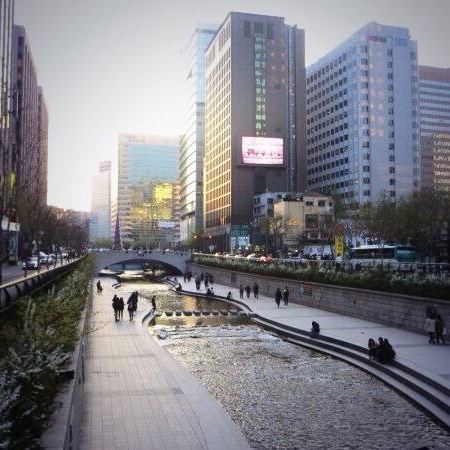 Mayor Jorge Elorza appeared with his team from Providence Planning to present a draft proposal for the 6/10 Connector Monday night. The plan took the form of a parkway.
Mayor Jorge Elorza appeared with his team from Providence Planning to present a draft proposal for the 6/10 Connector Monday night. The plan took the form of a parkway.
The looming context of the meeting was Governor Gina Raimondo’s September 7th announcement to rebuild the highway as-is. Though the bridges in question remain open to car and truck traffic, Gov. Raimondo and Rhode Island Department of Transportation Director Peter Alviti have maintained that the condition of the bridges creates an emergency situation in which the planning process must be severely curtailed. On the 7th, Director Alviti stated that the surface boulevard was “dead”. [It seems like this would be well known, but for full disclosure, that boulevard proposal came through the group Moving Together Providence, of which I am one founding member].
If there had been any hopes that the City of Providence would reignite the boulevard proposal, it did not happen Monday. The parkway plan honed very close to the design of a highway. The city’s plan made a number of changes to the RIDOT proposal that improved neighborhood connectivity through biking and walking access.
I’m going to take off my objective journalist hat and comment on some things I liked and did not like, as well as some things I continue to have questions about, as we move forward.
Good: Reclaiming Land
While the parkway continues to take up an extraordinary 240’ of width, the city’s plan nonetheless reduces the footprint in places to half of what the highway would be. This has allowed the city to claim fifty of the seventy acres originally expected to be developable under the surface boulevard proposal.
The Providence proposal reclaims significant land in Olneyville, with a phase two proposal to extend DePasquale Square into about half of the 13 acres of Federal Hill that were lost to the Dean Street exit/entrance ramps.
Good: Creating new connections for Smaller Streets like Magnolia and Tobey
As a former resident of Tobey Street, one of my favorite proposals was changing the Tobey Street on-ramp into a bridge connecting Federal Hill to Olneyville. Street grid connections like this are a good idea.
Bad: Continued Use of Traffic Pseudo-Science
Traffic engineers who are in any way honest understand that it does not make sense to do traffic counts on a road and then plan capacity for that roadway accordingly. Numerous highways have been removed and seen a significant part of the traffic that uses those highways disappear, and this is such a common occurrence that it is now a routine understanding. Given the political context of pressure from RIDOT to reify traffic counts, the City of Providence Planning Department did the logical thing, which was to base its various proposals on projections about how many cars would be on 6/10. This is going to make many of the otherwise reasonable proposals less livable. It’s a shame to see the boulevard proposal die on the western half of the roadway that inspired Cheonggyecheon.
Good: Preserved Space for Enhanced Amtrak and MBTA Upgrades
While Amtrak continues to look into whether to reorient the highly-traveled Northeast Corridor through Worcester instead of Providence, the Planning Department’s proposal to keep land open for enhanced rail travel is an important part of the economic and quality-of-life picture.
Bad: Stroad Design for Connecting Streets
The images used for connecting streets were four lane roads with anemic looking bike lanes alongside them. Urban streets should be two lanes, with even the most traffic-oriented streets getting two lanes with a turn lane. The bike lanes put in these proposals are anemically narrow (Dutch infrastructure goes for 4 meters to allow bikes to pass one another) and is without separation. These streets need a road diet.
Bad: Bait-and-Switch on the Roundabout
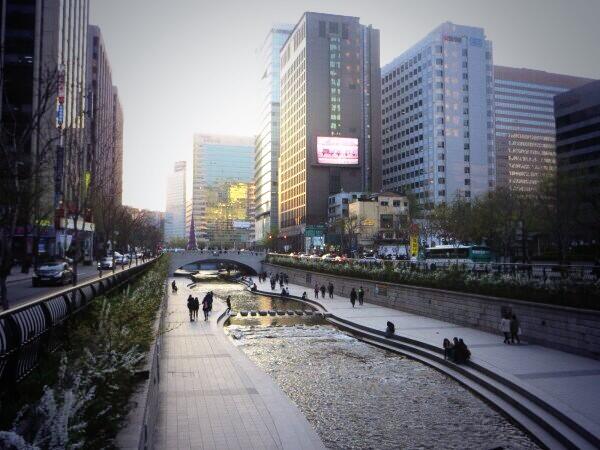 The Providence Planning proposal made use of a widely circulated image of a raised roundabout in the Netherlands, which serves bicycles crossing a Dutch highway. Problematically, this image was intended to go besides a proposal for a raised car roundabout to connect Routes 6 East and West and Route 10.
The Providence Planning proposal made use of a widely circulated image of a raised roundabout in the Netherlands, which serves bicycles crossing a Dutch highway. Problematically, this image was intended to go besides a proposal for a raised car roundabout to connect Routes 6 East and West and Route 10.
Roundabouts are not inherently a bad idea, but the use of this Dutch image is misleading. (Surface) roundabouts are an economical and safe way to connect roads that are high volume. (Would a raised roundabout that of course has many structures holding it up be cost-effective? That remains to be seen). They cost less than signalized intersections and usually allow more steady flow of traffic, causing them to be the default treatment in some states. Smaller roundabouts like the one carried out in Poynton, UK can be used in such a way as to create more pedestrian friendly areas while moving a surprisingly large number of vehicles. Larger roundabouts like those seen on Parisian boulevards can also carry a lot of traffic, but are being greatly curtailed as Paris attempts to revitalize the pedestrian connections around its major squares. Dutch bike design takes pedestrian and bike crossings away from roundabouts, while using them as a connection for cars.

In short, the roundabout should be understood as what it is: part of the parkway (which is really just a word for a scenic highway). The other connections need to put bike, pedestrians, and transit in the forefront.
Bad: No Real RIPTA Vision
While Providence Planning presented its efforts to remove cars from Olneyville Square via the raised roundabout as a way of improving through-flow of RIPTA buses, this follows the same induced demand logic that other traffic congestion schemes follow. Making a more direct connection between 10 N and 6 W will definitely take cars out of Olneyville immediately, but the pattern is that within a very short time traffic will fill that space and find equilibrium. So plans to create transit improvements need to acknowledge that. One way to improve transit-flow and make Olneyville more business friendly would be to disallow car through-traffic (allowing cars to visit and park at the edge, but pedestrianizing the center of the square is an idea that has its origins with Jef Nickerson of GCPVD). Having designated areas of the square for bus travel would then allow for better transit flow, though Providence Planning should be cognizant of the dos and don’ts about pedestrian spaces.
There also should be Bus Rapid Transit on the boulevard itself. I’ve pointed out in the past that while BRT does have some costs associated with it, a lot of the biggest costs going along with the RIDOT BRT proposal were added lanes for the BRT, and skyway bridges to connect pedestrians to center stations on a highway. A parkway continues to be a road designed with high speeds in mind, and I’m not certain how BRT could be best handled on a roadway like this, but I think it should be explored.
Getting Mugged by RIDOT
Two television stations and two newspapers asked me what I thought of the plan, and I compared it to a mugging. The Rhode Island Department of Transportation has very transparently used safety concerns about the Huntington Bridge to torpedo normal rules of process for deciding what to do with the highway. Essentially, Providence Planning has its back against the wall, and RIDOT is saying, “Your money, or your life?” Given that very limiting context, what Providence produced was a reasonable compromise that I can live with, in the same way that I accept other unpleasant realities forced upon me. I think the plan is leaps and bounds ahead of RIDOT’s proposal, but that’s not setting a high bar.
]]> Governor Gina Raimondo and Providence Mayor Jorge Elorza disagree on whether emergency repairs needed for bridges across the 6/10 connector means the grassroots idea of turning the highway connector into a boulevard is now off the table.
Governor Gina Raimondo and Providence Mayor Jorge Elorza disagree on whether emergency repairs needed for bridges across the 6/10 connector means the grassroots idea of turning the highway connector into a boulevard is now off the table.
At a news conference today, Raimondo said the boulevard idea is dead because emergency repairs to seven of nine bridges over the 6/10 connector need to be fast-tracked. But Providence Mayor Jorge Elorza disagrees, according to his new communications director Emily Crowell.
“Not at all,” Crowell said when asked if the mayor agrees with the governor that the boulevard idea is unfeasible because of the emergency repairs the announced today. “We’re not abandoning the idea to make the 6/10 connector multi-modal.”
Raimondo and Department of Transportation Executive Director Peter Alviti announced that the 6/10 connector needs emergency repairs. Those emergency repairs, they both said, effectively take off the table the grassroots idea to turn the 6/10 connector into a boulevard instead of repairing it. The repairs to the Huntington Avenue bridge need to be finalized in 60 days.
Elorza spoke at the State House event today.
“We can invest these dollars in a way that ensures the public safety of this roadway and also enhances the livability of this entire corridor,” he said. “It’s our responsibility to advocate for the smartest investment of these dollars to move the city and the state forward and that is what we will be doing at the table alongside RIDOT and the governor’s office to advance this project.”
Raimondo and Alviti were unequivocal that the emergency repairs means the boulevard idea is off the table.
“We have to move immediately, so some options are closed” said Raimondo, when asked about the boulevard idea. “The time is out for debate. It’s time for action. I would love to be able to take a longer process but I don’t have that option.”
Alviti said, “Hypothetical plans or other scenarios could be explored in the world of theory but in the world of reality we are facing we now need to address this structurally deficient problem.”
Raimondo added that just because the boulevard idea can’t be done doesn’t mean some smart growth measures are off the table for the highway that cuts through the west side of Providence. “We’re going to take the next couple months to listen and if there are opportunities to put in a bike lane, we will listen.”
Raimondo and Alviti said that seven of the nine bridges over the 6/10 connector are “structurally deficient.” Because the problem is more severe than initially thought, these repairs are being fast-tracked.
“Not only is the bridge defunct,” said Alviti, “but the plan to fix the bridge is defunct.” He said the 6/10 connector bridge repair have been in the works for 30 years, but they have also been without funding for 30 years.
Simultaneously, a grassroots effort to replace the 6/10 highway connector with a boulevard was gaining momentum. James Kennedy, a regular RI Future contributor who has been covering the 6/10 boulevard idea, took to Twitter to criticize the announcement.
]]>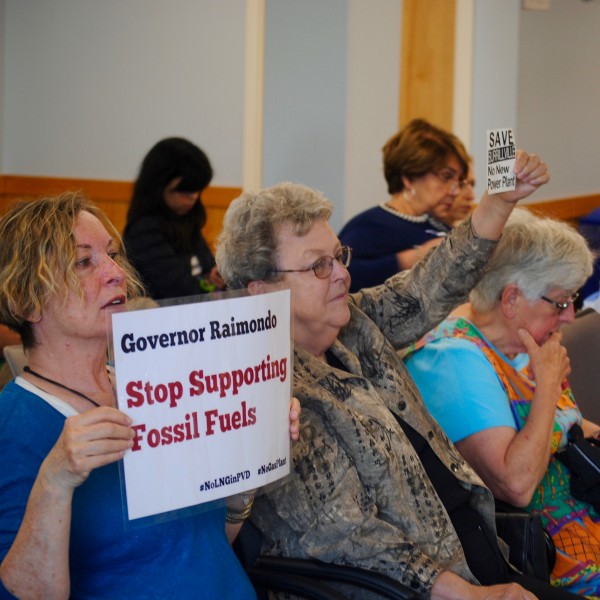 The June 2 open meeting of the Energy Facilities Siting Board (EFSB) was a rare opportunity to hear board members Margaret Curran, Janet Coit and Parag Agrawal talk openly about their thoughts regarding the process of the board in approving or denying Invenergy‘s proposed fracked gas and diesel oil burning power plant in Burrillville. That said, it’s also a bad idea to draw too many inferences about board members thoughts based on their words.
The June 2 open meeting of the Energy Facilities Siting Board (EFSB) was a rare opportunity to hear board members Margaret Curran, Janet Coit and Parag Agrawal talk openly about their thoughts regarding the process of the board in approving or denying Invenergy‘s proposed fracked gas and diesel oil burning power plant in Burrillville. That said, it’s also a bad idea to draw too many inferences about board members thoughts based on their words.
One example of this came near the end of the 45 minute meeting. Janet Coit, who directs the RI Department of Environmental Management (RIDEM) when she’s not on the EFSB, suggested directing RIDEM to expand their advisory opinions on the environmental impact to include impact on wetlands, impact on state conservation areas and the cumulative impact of all fossil fuel development in the area, including pipeline compressors and the Ocean State Power Plant.
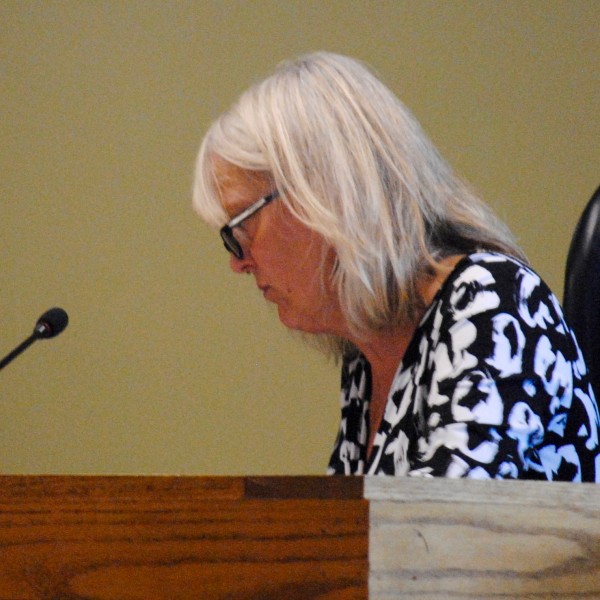
It would be easy to see Coit’s suggestion, which was approved unanimously by the board, as indicative of a concern about environmental impacts and as a response to the concerns of community members who have spoken at one or more of the open comment hearings held in Burrillville. But Coit’s suggestion may be no more than an attempt to make sure all the bases are covered. Getting advisory impact statements does not take away the EFSB’s ability to rubber stamp the power plant. It just provides the board with appropriate legal cover.
Chair Curran was on board with the suggestion that the cumulative effects the fossil fuel infrastructure in Burrillville might have on wildlife, saying, “I’m partial to the bats.” But again, her concern for the bats might dissipate in the light of Invenergy’s desire to build a new power plant where it is not wanted.
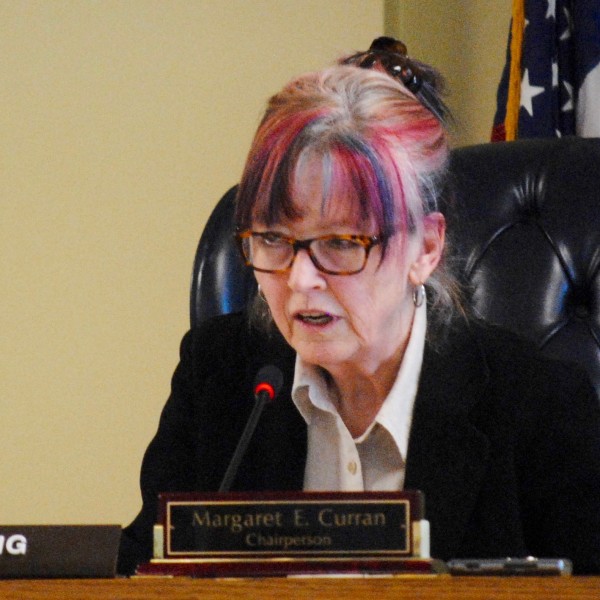
Coit also suggested that the EFSB take “official notice” of the court order that closed the MTBE contaminated well in Pascoag, the same well that Invenergy hopes to use to cool their turbines on the promise of cleaning up the contamination. The well was sealed after many families became due to the MTBE in their water. As a result of Coit’s suggestion the court order has become part of the official record.
There were no public comments allowed at this meeting, and no lawyers from any of the intervenors were allowed to ask questions or comment. The meeting was for the three board members to “discuss, deliberate and decide” on various aspects of the hearing process. They started by denying one “late intervention” of an abutting property owner and approving another. The difference between the two applicants seemed to be that one applicant was zoned for residential and business, a special case that may require a separate lawyer.
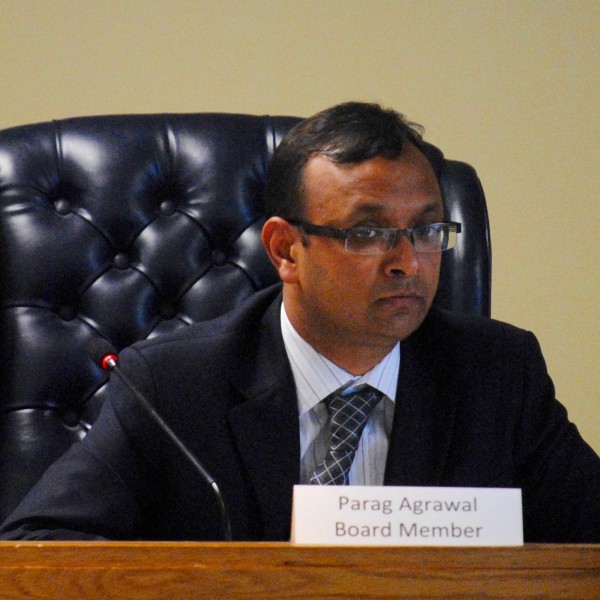
Todd Bianco, coordinator of the EFSB, ran through the current status of the advisory opinions the board has requested. Most of the opinions seem to be roughly on schedule. Surprisingly, Invenergy has yet to apply for the proper permits from the RI Department of Transportation (RIDOT). Under current rules, it would take RIDOT three months to process the applications, and Bianco said RIDOT was “unable to determine if the applications will be on time.”
The meeting ended with a discussion of how to do better outreach with the public. Bianco said that he continues to run advertisements for meetings in the ProJo and in two local Burrillville publications. This lead to a discussion of whether or not to have a Twitter account for the EFSB.
“It would be my first,” said Bianco, “I could learn how to tweet, and hashtags are a thing…”
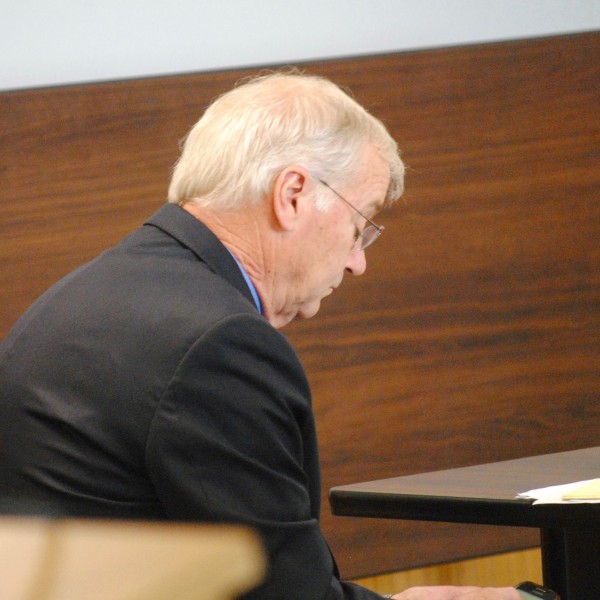
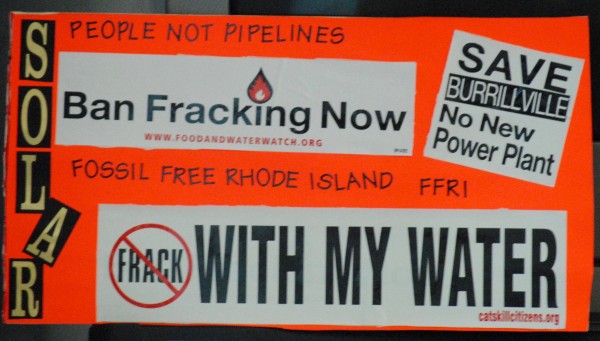
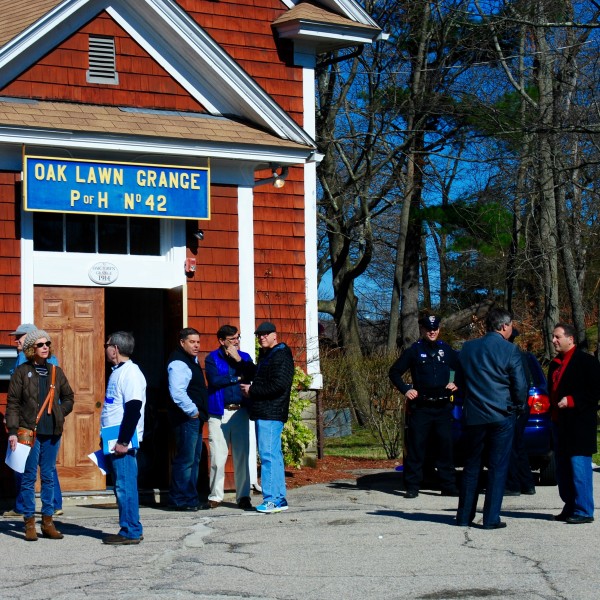 I got to the event a good half hour early. As I crossed the small parking lot outside the Oak Lawn Grange I was intercepted and asked about my business.
I got to the event a good half hour early. As I crossed the small parking lot outside the Oak Lawn Grange I was intercepted and asked about my business.
“I’m just here to take notes and a few pictures,” I said, “for RI Future.”
Pause. “We’re not set up yet,” said the man, “you’ll have to wait.”
“Okay,” I said, “I’ll sit over at the picnic tables.”
“Sure,” said the man, “Why not? It’s a beautiful day out.”
It was. I sat for a few minutes, reading my phone, when another man holding a clipboard approached me. We introduced ourselves. He was Leo Skenyon, Nicholas Mattiello’s chief of staff.
“I don’t know if we can get you in,” said Skenyon, “We’ve got over 130 people coming, and priority will be given to Cranston residents.”
“Okay, “ I said, “I get that. I can stand. I just need to take some notes and a few pictures.”
“We might get you into the basement with a TV,” said Skenyon, “You’ll be able to hear the answers, but you might not hear the questions.”
“We’ll see what happens then,” I said.
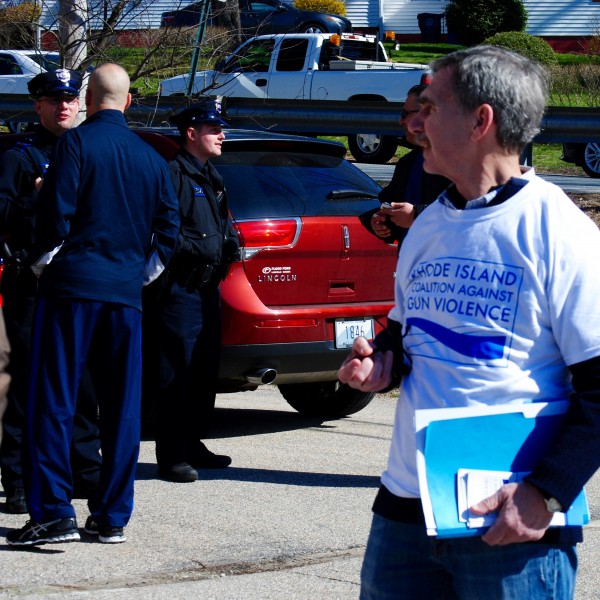
I waited outside near the entrance, watching people arrive. I saw two people from the Rhode Island Coalition Against Gun Violence (RICAGV) handing flyers to passers by. One of them was Tom Wojick.
“Do you support common sense gun legislation?” asked Tom, holding out a flyer to a man and his wife.
“No,” said the man, “I’m a NRA member.”
I had taken a bus on a Saturday morning to the middle of Cranston to see Representative Nicholas Mattiello, the Speaker of the House and arguably the most powerful politician in Rhode Island, engage with his constituents.
This isn’t an every day occurrence. Some reps have regular events with their constituents, some have none, but as Mattiello told the crowd, his duties as Speaker take up a lot of time, and he doesn’t often get the chance to hold events like this. Today was a rare chance to see Mattiello engage with his constituents and hear what voters in Mattiello’s district care the most about. [Spoiler: It’s RhodeWorks]
Mattiello wasn’t alone either on stage or behind the scenes. Organizing the event were about a dozen men delivering coffee and donuts, escorting people to their seats and acting as what seemed like de facto security. There were two Cranston police officers stationed at the event. In addition to Leo Skenyon, who was organizing, I saw Larry Berman, communications director for the RI House of Reps, helping out.
On “stage” with Mattiello were RI State Senators Frank Lombardi and Hanna Gallo, Rep Robert Jacquard and RI Department of Transportation director Peter Alviti, there to answer technical questions about truck tolls and RhodeWorks.
When I entered the Grange Larry Berman saw me and said, “He can come in,” but behind me Leo Skenyon said, “He’s taking a couple of pictures and heading downstairs.”
That’s what I did. Here’s one:
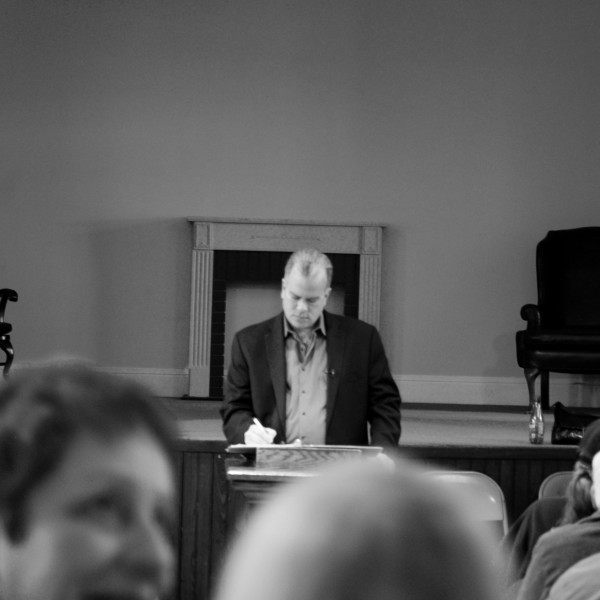
Downstairs in front of the TV was a man who was interested in RhodeWorks but happened to live in Providence, so he was sent to the basement with me. A minute later we were joined by Lorraine Savard, wearing a small version of her “Save Burrillvile: No New Power Plant” sign pinned to her lapel.
At least I was in good company.
We ended up watching everything on closed circuit TV, downstairs from the main event. We laughed when the camera upstairs went to a wide shot, showing at least seven empty seats in the main room. We laughed again when we noticed that the two police officers were in the downstairs room with us, leaving no police presence in the room above, where over one hundred people were in attendance.
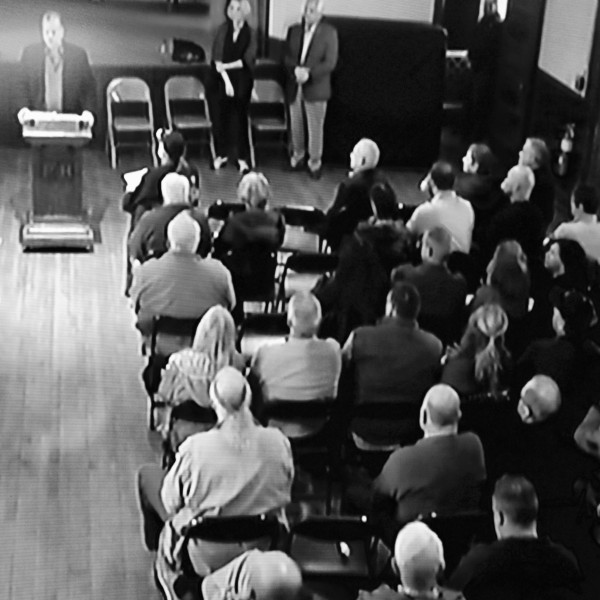
Most of Mattiello’s talk was a defense of RhodeWorks. One idea the Speaker was keen to dispel was that RhodeWorks was broadly unpopular. He said that he has in his district 14 thousand constituents and 10 thousand registered voters. When he counted the number of emails he received opposed to RhodeWorks, it was thirty.
“I don’t believe that,” said the man from Providence sitting next to me.
But I don’t think Mattiello lied. People in Mattiello’s district aren’t that upset about RhodeWorks, or at least not upset enough to threaten him politically. Mattiello maintains that the reason people don’t like RhodeWorks is because they are misinformed about it.
“We have a talk radio community,” said Mattiello, “misinformation gets out through that medium” either through callers saying things that aren’t true or talk show hosts repeating false information.
“Misinformation takes your vote away from you,” said the Speaker.
Lombardi and Jacquard also defended their RhodeWorks votes. Lombardi said, “We live in a post 38 Studios world. RhodeWorks opposition is based on a distrust of [any] legislation, not on the plan itself.”
Gallo went a different direction, touting the work she does on education, including full day kindergarten.
Eventually the question and answer phase of the discussion, nearly three hours into the event, got around to a subject other than RhodeWorks. A woman (it was very hard to hear the specifics of her question on the TV) asked about the three bills the RICAGV has brought forward, including the bill to prohibit people with concealed carry permits from bringing guns into schools.
“There are two sides to this issue,” said Mattiello (who incidently has an A+ rating from the NRA), “There are those who want no change [to our guns laws] and there are those who want to abolish guns.”
This opening surprised me. The RICAGV has worked hard to strike a nuanced position on guns, and here Mattiello was claiming that the group was simply seeking to abolish all guns.
As for guns in schools, said the Speaker, “Please tell me where this has been a problem. And if its never been a problem, you’re affecting the rights of law abiding citizens.”
Mattiello gave the hypothetical situation oaf a man with a concealed carry permit picking his kid up at school. Is he supposed “to leave his gun on the sidewalk? Leave it in his car where it might be stolen, or drive home and drop it off first?”
“In trying to solve a problem you’re creating a bigger problem,” said the Speaker.
Guns are not allowed in courthouses or airports, countered the woman (and I might add, not allowed in the State House where Mattiello works either.)
Senator Lombardi cut in at this point, saying that the problem isn’t gun owners, it’s the mentally ill accessing guns. Columbine and Sandy Hook were the results of mental illness, said Lombardi, not lack of gun control.
“If,” said Lombardi, “God forbid, a [gunman] goes into a Cranston school, I hope the first person he sees is a law abiding citizen with a concealed carry permit.”
“We have to address the mental health aspect of this equation,” added Mattiello, “People with concealed carry permits are not the problem. I don’t think they’ve ever been the problem.”
Mattiello’s last words on the issue of guns were, “You can affect the behavior of people who respect the law, but not the behavior of those who don’t respect the law.”
That kind of makes me wonder why we pass any laws.
The next question was about the ethics commission.
“Senator Sheehan’s bill is the worst bill I’ve ever seen,” said Mattiello, “I can’t imagine supporting that bill because it make’s no sense to me.”
“Conflict of interest rules are ‘gotcha’ politics,” said the Speaker, “lawyers in the General Assembly serve clients across the country. Technically they are always in conflict of interest. They would never vote!”
Mattiello feels that Sheehan’s bill will encourage “frivolous complaints”. “What’s going to happen is good people are not going to want to run [for office],” said the Speaker.
“Most people in government are extremely ethical,” continued Mattiello, “Everybody up there, I believe, is entirely ethical and good.”
Mattiello seems to believe that the job of identifying conflicts of interest falls to the fourth estate, saying, “Kathy Gregg is a great reporter. She points out every conflict of interest.”
Somewhat echoing his last word on gun control laws, Mattiello said about ethics, “Ethics commissions don’t make better people. That’s [the electorate]’s job.”
Other random things of interest Mattiello said during the meeting:
“I disagree that the Speaker is the most powerful person in the state. Sometimes it’s the governor.”
Ex-Speaker Gordon Fox, now in prison, “had his problems but he did good things policy wise.”
“I don’t believe in trickle-down economics. I just want to be competitive with our neighboring states.”
“Rhode Island right now is in excellent shape.”
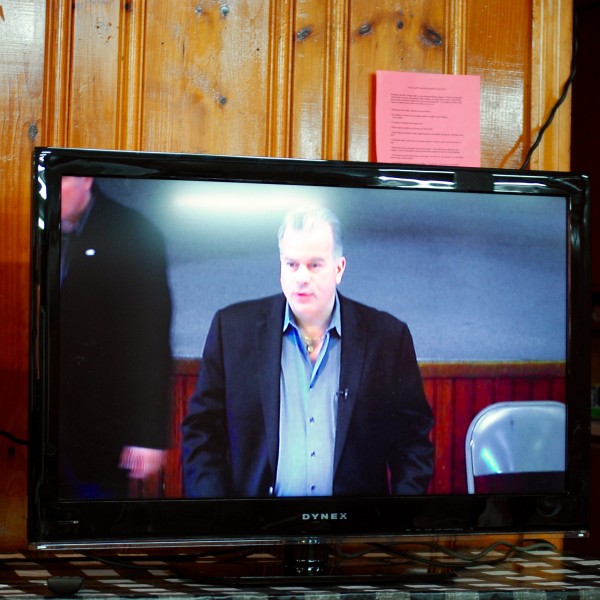
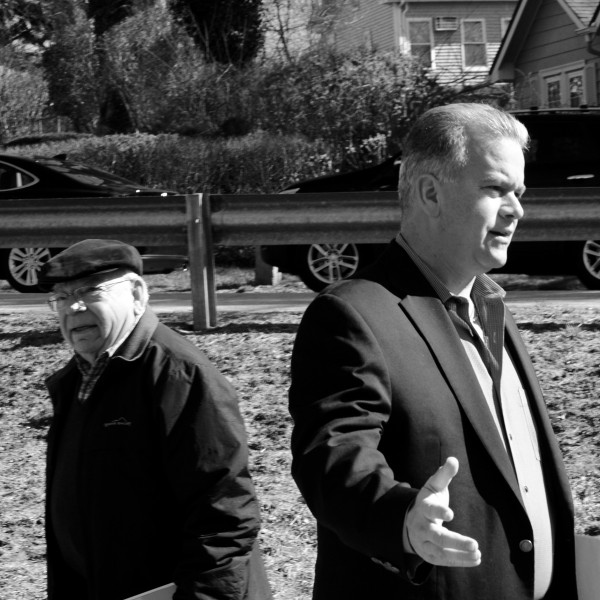
Deprecated: Function get_magic_quotes_gpc() is deprecated in /hermes/bosnacweb08/bosnacweb08bf/b1577/ipg.rifuturecom/RIFutureNew/wp-includes/formatting.php on line 4387
Deprecated: Function get_magic_quotes_gpc() is deprecated in /hermes/bosnacweb08/bosnacweb08bf/b1577/ipg.rifuturecom/RIFutureNew/wp-includes/formatting.php on line 4387
Deprecated: Function get_magic_quotes_gpc() is deprecated in /hermes/bosnacweb08/bosnacweb08bf/b1577/ipg.rifuturecom/RIFutureNew/wp-includes/formatting.php on line 4387
Last Wednesday, RIDOT presented what it is calling a “boulevard-highway hybrid” model of the 6/10 Connector. I’ve dubbed their proposal “6/10 Dig” because it replicates the mistakes of the “Big Dig” in Boston. Our proposal at Moving Together Providence continues to be a true 6/10 Boulevard. Kevin Proft at Eco RI News has done the best comprehensive coverage of this topic of anyone in the media so far, and even I can’t try to reconvene all the information he put together, so please check out his piece.
There are many people who would benefit from the 6/10 Boulevard, but why should drivers support it over the 6/10 Dig option?
RIDOT is wrong. . . It’ll take too long. . .
Cost
A boulevard is a hybrid by nature. The nonsense “highway-boulevard hybrid” name really just means a capped highway, like the Big Dig. The Big Dig was the most expensive highway project in U.S. history. While the Big Dig produced a really nice park for downtown Boston, it left the problems of the highway untouched elsewhere. The same will be true for a 6/10 Dig.
Why is a boulevard cheaper? The 6/10 Connector highway is full of bridges that need to be fixed, and those bridges span parts of the highway itself, as well as over the highway. If we built a boulevard, we could build bridges only over the Northeast Corridor tracks, and that would make the bridges 80% shorter.

The capping process for RIDOT’s 6/10 Dig also essentially requires digging and covering two tunnels, in a river valley floodplain. This inherently adds all sorts of unforeseen and difficult-to-predict costs that are not part of a boulevard project. The Alaskan Viaduct, which Washington State’s DOT forced down the throat of Seattle after ignoring two referenda that rejected it, is currently an example of how this can go horribly wrong. Big Bertha, the tunneling device that was specially made to dig the Alaskan Viaduct, has gotten stuck several times. There is also ominous settling of buildings in Seattle’s downtown, suggesting that the tunnel may be undermining the foundations of the buildings. These cost overruns in Seattle are a warning against this approach, just like the numerous cost overruns in Boston were.
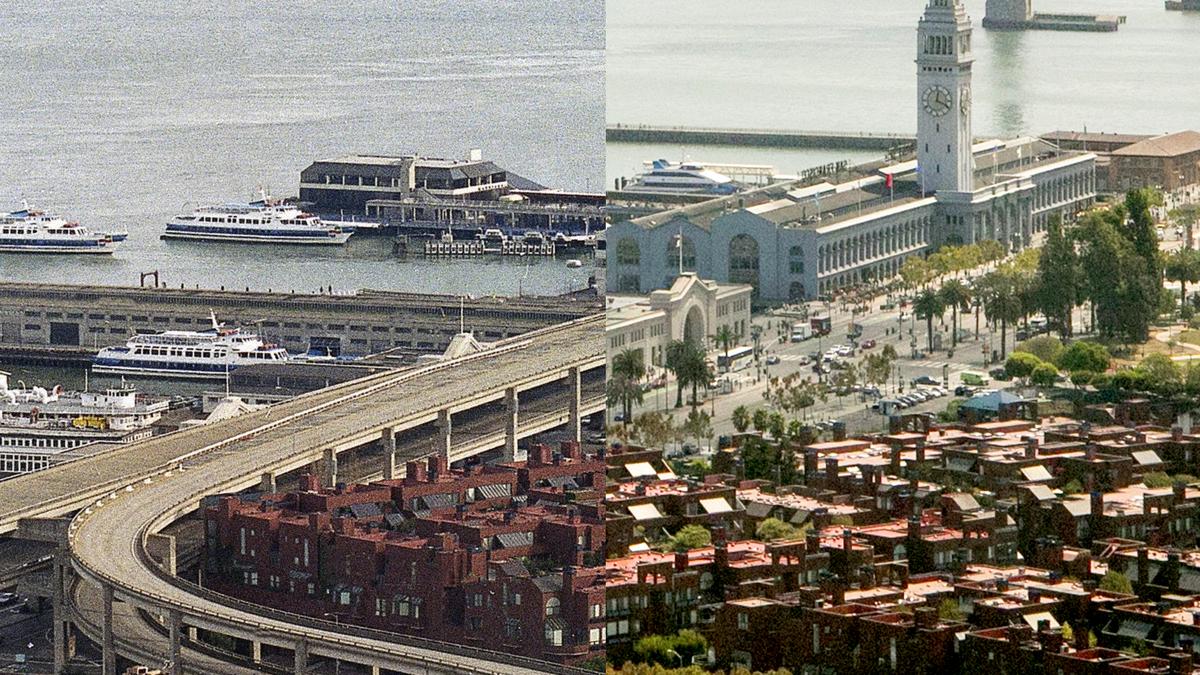
The 6/10 Dig also keeps a highway form to the road, which means it needs exit and entrance ramps. That not only means spending money to build and maintain those ramps, but it means negatively affecting the development pattern for 70 acres of land that would be available in a boulevard model for development.
RIDOT’s 6/10 Dig proposal: spend more to do an uglier job that will leave less potential to earn taxable income in the future.
Moving Together’s proposal: save now, do a nicer job, and add potential development. We also support reducing the toll amounts to reflect whatever surpluses become available from our model.
Congestion
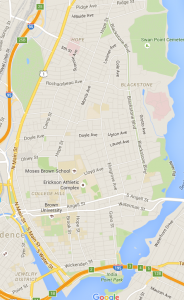 A few people have started to send me angry tweets or emails about how I’m attempting to drive them out of their car. And while I would very much welcome people choosing to drive less, as evidenced by lots of my writing, I’d like to remind people that you can drive on a boulevard. In fact, boulevards originally were a widening of streets that had been much narrower. The Champs Elysée was thought up by Emperor Napoleon III to prevent further revolutions in France’s capital. Today it carries 60,000 cars and 500,000 pedestrians a day.
A few people have started to send me angry tweets or emails about how I’m attempting to drive them out of their car. And while I would very much welcome people choosing to drive less, as evidenced by lots of my writing, I’d like to remind people that you can drive on a boulevard. In fact, boulevards originally were a widening of streets that had been much narrower. The Champs Elysée was thought up by Emperor Napoleon III to prevent further revolutions in France’s capital. Today it carries 60,000 cars and 500,000 pedestrians a day.
Why does a highway work less well for cars than a boulevard? First off, we’re talking about urban highways. A rural highway is a totally appropriate piece of infrastructure that carries cars quickly. An urban highway fails because it blocks many of the advantages that cities have to deal with traffic.
The East Side is a part of Providence that has been (relatively) less affected by highways than other parts of the city. It does have I-195 cutting across its waterfront, which carries its own issues, but unlike Downtown Providence or the West Side, Olneyville, and Silver Lake, it has no highways cutting it directly off from other parts of itself.
Wouldn’t an Angell Street Expressway improve traffic congestion? After all, the East Side has some of the largest employment centers in the state, and because many of the jobs it serves are high-income, a sizable portion of its workforce chooses to live outside the city and commute by car. A hypothetical Angell Street Expressway helps to explain what’s going on in Olneyville with traffic.
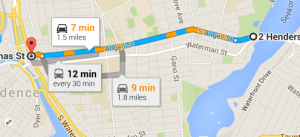
If you look at a map of the East Side, you’ll see that north-south there are fifteen pairs of streets between Butler and Main Street, inclusive. That’s fifteen streets, each with two lanes.
Google says it would take 7 minutes to go up Angell Street at the current speed limit. Having an expressway might half that time, in theory.
But what of those north-south trips? In order to make the highway work at high speed, it would have to be limited-access, meaning that it would have only a few entrances and exits. All of the traffic that currently flows through 30 lanes of small streets would have to cross the highway at odd intervals– perhaps at Main St., Hope St., and Gano St.
This would be a disaster, but that wouldn’t be the only thing about the Angell Street Expressway that would be messed up for drivers.
A hypothetical Angell Street Expressway would need exit- and entrance-ramps for those three stops. I took a screenshot of an area of the map roughly the size of the Viaduct and placed it over Thayer Street. There’d be a second one like this on the other side. Several blocks of housing and businesses would have to be removed in between the exit- and entrance-ramps, for the full length of the highway. And two more sets of exit- and entrance-ramps would be needed at Main and Gano, respectively.
Would this have a further effect on driving times? Of course. Currently, many people walk on the East Side, and that contributes to the fact that Thayer Street is lively even sometimes during blizzards, and can have tremendous success drawing people for business when the street is closed to cars. Suddenly every trip would need to be driven. And the lack of a grid would mean that people who were driving short trips would take the highway to get around and through this maze.
The East Side is not perfectly uncongested, especially on Thayer Street itself, which is very popular, and narrow. But doesn’t it seem odd that a part of the city where the most employment and economic activity is happening manages without an Angell Street Expressway, but Olneyville– a part of the city that is depressed, and has a nearly 50% non-car-ownership rate, but no major industries– has constant traffic? Olneyville Square at 3:30 on a Wednesday looks like Thames Street on 4th of July in Newport, but with none of the apparent economic activity driving that congestion.
A capped highway could connect some streets, because the connective parkland built over the highway might be wide enough to slightly expand the range of choices to drivers. But it would do so at great cost now, and into the future, and so the number of bridges that could be built would be limited. A boulevard, because of its low cost, could reconnect almost all the streets on either side, and at much less cost. And what that means is that instead of having to sit through Olneyville Square to get to a highway that will be almost as backed up, you can glide along a number of streets in a connected neighborhood.
A Tested Idea

We’ve already been here, and it wasn’t any flower-sniffing hippie that brought us there. The late Buddy Cianci moved train tracks and a river to put together Memorial Blvd and Waterplace Park, both of which have been successful by any measure. But because of the weird engineering choices that had to go into those projects, they were obviously very expensive. By contrast, the 6/10 Boulevard project does something we’ll have to do one way or another: tear down the old 6/10 Connector. The only thing that is different is it calls for not rebuilding the monstrosity. By saving money, we can lower tolls. We can add development land to the tax revenue of the state and city. But we can also better support drivers by removing the old grey wall that currently stands in their way.
~~~~
UPDATE: Addressing some other concerns.
The Great Northwest Passage
Lewis & Clark, here I come.
Boulevard proponents do not intend to remove the whole of Rt. 6. This is something that keeps coming up as a concern, and that is something I want to address here.
It’s It’s It’s understandable for people not to know this, since everyone in the state shouldn’t be expected to live and breathe the 6/10 Connector as I do, but the Moving Together Providence proposal does not make any changes to the northwest corridor of Rt. 6. Our proposal calls for the boulevard to transition back to a highway somewhere around Hartford Avenue north. Where the map cuts off to the northwest is roughly where such a transition to a highway could go. It’s not nearly as harmful to have Rt. 6 along the edge of Manton into Johnston as it is to have it cut through other parts of the city as the 6/10 Connector, because there are not meaningful historic commerce or community connections being blocked. The Woonasquatucket Greenway already exists parallel to this section of highway.

Justin Katz of Ocean State Current-Anchor happily surprised me when he endorsed the idea that the people of Providence should have the greatest say in the form of the 6/10 Connector, and that spurred a conversation in the comments section of his post. Commenters ShannonEntropy and Tom Hoffman brought up issues related to the interests of suburban commuters, citing the lack of a good “east-west” route (ShannonEntropy’s words). Hoffman, who has written in support of the boulevard as part of the labor-oriented Common Ground RI, did not mention an east-west connection in his comments on the piece, but has brought this issue to me in other conversations.
The search for the Great Northwest Passage led Lewis & Clark astray, and I think this concern is also wrongheaded here. Just to illustrate the point, let’s look at a density map of Rhode Island.
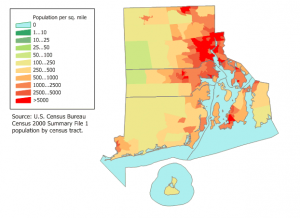
Yes, it’s clear that commuters from the northwest of the state use Rt. 6 if they want to come into the city– and they should continue to. No one– let me repeat that– no one is trying to get you to stop driving to Providence from Johnston or points northwest.
The issues that plague the 6/10 Connector don’t emanate from Johnston commuters. They emanate from the huge number of local trips that are misplaced onto the Connector by a lack of a street grid. All of the commuters from the northwest of the state could try getting on the highway at once, and my feeling is that even together, they’d have a hard time creating a traffic jam, but if even a small number of Providence residents are pushed onto the highway for the short trips they’re taking between neighborhoods, it would create a traffic jam. That’s what happens everyday.
There’s an enduring dream of a Great Northwest Passage out of Providence and across the state, and some wish that that passage would have also connected with I-84. I think that would be a mistake as well. The natural, self-organizing nature of commuter and residency habits has created no problem here. The 6/10 Connector has. If we’d knocked through the rural hinterlands of the state with an expensive highway addition, we would be causing Big Government to redefine and socially engineer that reality away from what it is.
How to transition?
How is this done? One of the cheapest, more congestion-fighting, and safest ways to transition a high-speed road to a lower-speed one is a roundabout or traffic circle.
Traffic circles have downsides, particularly for cyclists, which is why in the Netherlands, cyclepaths are usually routed around them. But for transitioning the edge of a city into a highway, roundabouts create a highly efficient compromise between pedestrian and car needs, which also costs a lot less than signaling. State DOTs like Wisconsin’s require roundabouts as the first consideration for all newly designed intersections, in part because they save money, and in part because they reduce the incidence and severity of crashes.
The example I use above is somewhat different than what I have in mind, but still illustrates the self-organizing nature of traffic in a traffic circle. The actual implementation of the idea as a transition point between highway and boulevard would differ because it would not be in the center of town, but rather on the edge of urban development towards something else. Philadelphia’s Eakin’s Oval– a transition between the very fast Kelly Drive/East River Drive and the boulevard-like Benjamin Franklin Parkway– and Logan Circle– the second transition, between the faster part of the Parkway and the much slower, more urban part near Philadelphia’s City Hall.
If you think, “Gee, the Ben Franklin Parkway doesn’t look that urbanist to me” you’re right. Jane Jacob’s hated the Ben Franklin Parkway, which she identified in The Death and Life of Great American Cities as a big-planner departure from the more organic street form of Philadelphia around places like Rittenhouse Square. But that’s the point, in a way: a boulevard is not perfect urbanism. It’s a compromise point between the needs of drivers to drive in the city, and the needs of the city to be a city. The Ben Franklin Parkway isn’t my favorite part of Philadelphia as a native of that region, but it is a beautiful and enjoyable one, and economically productive. It features widely on postcards of Philadelphia, as the endpoint of the famous “Rocky Steps” of the Museum of Art.
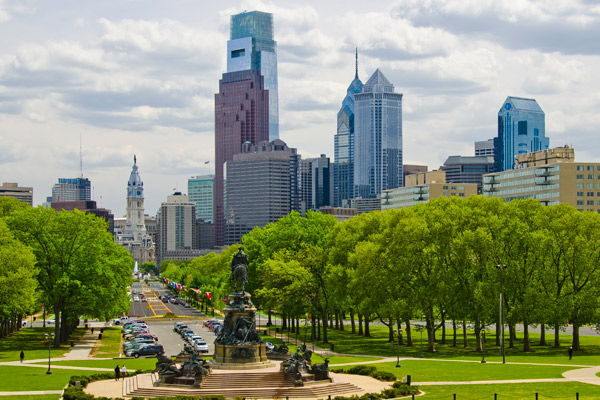
A failed vision
We should not use the most expensive item in our pantry for every purpose, but that does not make that item bad. The distortion of the American diet, many have pointed out, comes not from the “bad” foods we eat being “bad for us” so much as from the weirdly top-down planning that makes those foods everyday fare. This same paradigm affects driving, and transit.
Just to show you that I’m not biased against driving, let me give you a transit waste example.

The transit planner Jarrett Walker, out of Portland Oregon, produced a stunning redesign of Houston’s bus system. The Houston system had been bleeding ridership for many years, and Walker redesigned the system to be more comprehensive, more frequent, and more convenient, while not spending any extra money on it. Naturally this involved some tradeoffs, but the vast majority of previous riders of Houston’s buses continue to use the same bus stop now that the system has changed. Ridership is now increasing, instead of decreasing.
Walker has described how members of the public whose bus stop did change sometimes did not like the fact that they had to walk an extra quarter mile to get to the route, not understanding that buses don’t simply represent lines on a map, but also lines that have other dimensions– like frequency and span. If you have two buses to choose from, but they’re half as frequent, and their resultant low ridership means they stop at 7 PM instead of 12 PM, then the two buses are a less useful service than just one.
A bus is a cost-effective service if used right, but it’s also an expensive service that requires on-going maintenance and labor costs. Using the most expensive item in your toolbox– a bus– to meet the needs of a pedestrian trip does not make sense, especially if spreading those resources undermines both.
People often say I’m “the bike guy” because they misunderstand my point about bike routes. Bike routes an inexpensive tool, so the more we can meet the needs of commuters on bikes, and then use our more expensive tools like roads and buses sparingly, the better we’re able to marshall our resources to the best result for taxpayers and commuters.
If you want to meet the needs of disabled people, for instance, you could spread your bus resources really thin, and provide a bad bus service for everyone, or you could create a few very good buses for the same cost, but use the savings to fill the gaps with good pedestrian and bicycle infrastructure.
The failed vision of RIPTA is often to stop in each nook and cranny, to turn into each parking lot, to hit each 100 foot gap, and by doing so make the route take forever and work for no one but the most desperate. A better vision would have RIPTA marshall its resources towards the highest uses, and let bicycles and sidewalks fill in the gaps.
How that failed vision applies to roads
Urban highways were a utopian vision by planners like Le Corbusier. Here was Le Corbusier’s vision for Paris:
Y
You can see not only that this is an awful vision, but that it resembles the 1960s Big Government views of people like Robert Moses. What Le Corbusier misunderstood was that the apparent efficiency of highways doesn’t work in the context he imagined it. He forgot parking, he forgot traffic congestion, and most of all he forgot that highways are the dollop of expensive whipped cream on the pancake, not the pancake itself.
The RIDOT 6/10 Dig proposal reminds of this 1920s era, when planners thought they could direct each activity from above with unlimited resources. It’s an entrancing vision, actually, and if you forget how much it would cost, or how many resources it would swallow, you can almost see why it seemed like a great idea.
In a bus, the bus is the expensive option, and walking or biking is the final connection. They exist together. With a highway, the highway is the expensive option, and driving a city street is the final connection. To imagine that all the city streets would disappear into huge Jetsons-like highways, with towers-in-the-park between them, is wrong.
Why a boulevard?
A boulevard makes the most sense because it rejects the utopianism of Le Corbusier, and instead uses highways as the tool they’re meant for– long-distance travel between two productive places. The boulevard reconnects streets. Yes, there are commuters from the northwest, and because they come from suburban and rural areas, it is very likely that many of them if not all of them will continue to drive post-boulevard. But because their numbers are less great than our intuition says, that’s actually not a problem. The goal of a boulevard, or of any urbanist project, is not to force people not to drive, but to create the right set of options so that driving doesn’t become the only way around. Let’s take our heads out of the 1920s’ futurism, and build the 6/10 of today.
~~~~
]]>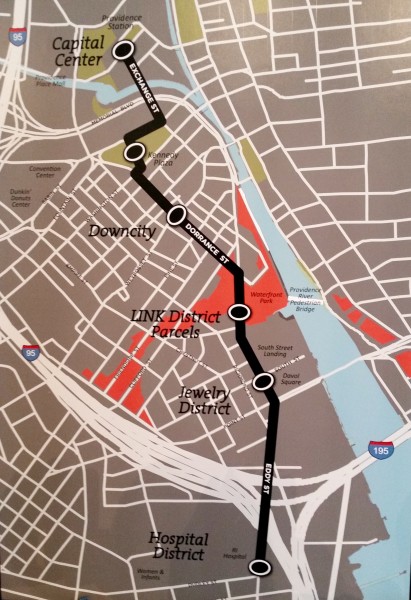 Providence Mayor Jorge Elorza today announced plans for a 1.4 mile “Enhanced Transit Corridor” in downtown Providence. The service will “run along Exchange, Dorrance and Eddy streets, providing quick and reliable transportation between Kennedy Plaza, two new intermodal transit hubs planned for the areas around the Providence Station and Hospital District, and key office, retail, entertainment and institutional destinations both within and beyond the Downtown area.” (See map)
Providence Mayor Jorge Elorza today announced plans for a 1.4 mile “Enhanced Transit Corridor” in downtown Providence. The service will “run along Exchange, Dorrance and Eddy streets, providing quick and reliable transportation between Kennedy Plaza, two new intermodal transit hubs planned for the areas around the Providence Station and Hospital District, and key office, retail, entertainment and institutional destinations both within and beyond the Downtown area.” (See map)
The project is being paid for with $13 million in TIGER VI funds, secured with the help of the congressional delegation. The total cost of the project will be $17 million, with the city and state kicking in the rest.
Elorza said that the increased cost of parking in Providence is creating a demand for dependable public transportation. The new route is projected to have buses running every five minutes during peak hours. A series of sheltered bus stops, similar to the one pictured below, from Cleveland, will provide WiFi and bike share service as well as other amenities.
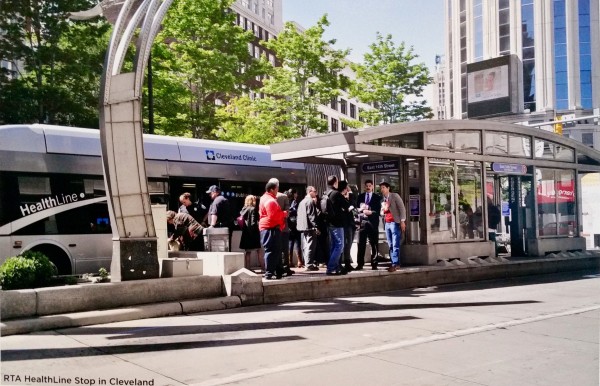
Governor Gina Raimondo said that when she talks to businesses, they are seeking young talent, and that young people want public transportation. This is born out by a pair of statistics mentioned by Congressperson David Cicilline, who said that “4 out of 5 young people want to live without a car” and that “two-thirds say access to public transit is a key factor in deciding where to live.”
Don Rhodes, of the RIPTA Riders Alliance, told me that he is very pleased with the new plan, and that he and his group has been advocating for an enhanced bus route instead of a streetcar for years.
The new plan is the result of a collaboration between RIPTA, the RI Department of Transportation (RIDOT) and the City of Providence.
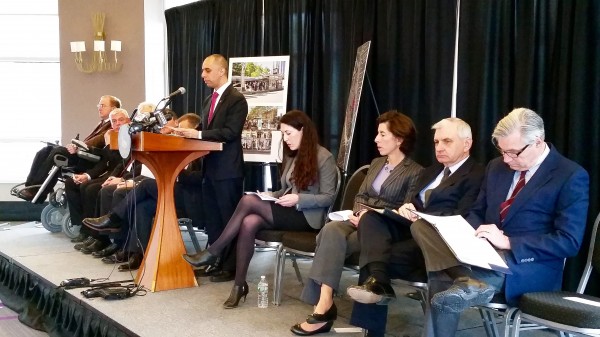
 EFSB Chair Margaret Curran said that because of the “tight time schedule” it’s critical that the board get advisory opinions “as soon as possible,” raising the question as to why the board feels the need to rush Invenergy‘s application process.
EFSB Chair Margaret Curran said that because of the “tight time schedule” it’s critical that the board get advisory opinions “as soon as possible,” raising the question as to why the board feels the need to rush Invenergy‘s application process.
The EFSB also denied all but two motions that were brought before it today.
The Energy Facilities Siting Board (EFSB) met today to decide a number of issues pertaining to the “Clear River Energy Center” a new methane gas power plant planned by Invenergy for the Town of Burrillville.
Things did not go well for opponents of the plan.
Curran began the meeting reminding those in attendance that their would be no public comment. This did not stop people from standing and loudly declaring their dissatisfaction with some decisions made by the board.
EFSB board member Janet Coit, director of the Department of Environmental Management (DEM), asked that people “respect the process” and stressed that there would be ample opportunity for public comment. Then the board began making their decisions.
Dennis and Kathryn Sherman and Paul and Mary Bolduc whose properties are near the site of the proposed plant and whose interests are not covered by any other intervenors, were granted intervenor status by the EFSB.
The Rhode Island Progressive Democrats (RIPDA) were denied. They do not have an adequately expressed interest.
Fighting Against Natural Gas (FANG) and Burrillville Against Spectra Expansion (BASE) are also denied, their intervention was decided to be not in the public interest.The simple allegation “however heart felt” of public interest is not enough.
Fossil Free Rhode Island (FFRI), Sister Mary Pendergast and Occupy Providence filed identical applications, and there is no reason to grant intervenor status said Curran and Coit.
Peter Nightingale, from Fossil Free RI, issued the following statement upon the group being denied intervenor status:
“Rhode Island government may decide to sell Rhode Island down the “Clear River.”
- “If it does, it may have acted in accordance with twisted statuary law.
- “But government, in that case, will have failed in its fiduciary duty to protect the natural resources —air, land and water— it holds in trust for the People.
- “When the time comes, those responsible will be held accountable for their crimes against humanity and nature.”
Nightingale was escorted from the room by security when he rose and loudly read his statement to the board.
Pat Fontes, representing Occupy Providence, also rose and spoke, as she left the room. Fontes said, in a statement, “The predator’s pursuit of profit produces pain for poorer people. It’s the weakest who inherit the consequences without ever having their opinion about the risks taken into account.” She said, “Remember Flint, Michigan!” as she left.
Sally J. Mendzela‘s motion was dismissed because her ideas were “outside the scope” of the process.
The Burrillville Land Trust‘s motion for intervention was denied. Their concerns will be dealt with by the DEM, said the board. “I think their will be other opportunities” said Coit, for the Burrillville Land Trust to make their concerns known. The Land Trust’s motion to close the docket was rendered moot by their denial of intervenor status.
Paul Roselli, president of the Burrillville Land Trust was not surprised by the Board’s decision. He maintains that the issue of biodiversity will not be covered. The impact on species is dependent on an individual species’ status as endangered or threatened, etc. The overall or “holistic” impact of something like Clear River is not considered, and this is the perspective Roselli hoped the Land Trust would bring.
Still, some good came out of the Land Trust’s motion. Invenergy’s application has been updated to ensure compliance with section 44 of the Clean Water Act.
RI Administration for Planning, Office of Energy Resources, the DEM, the RIPUC, RIDOT, the Department of Health and other state agencies will all be asked for advisory opinions. Curran says that because of the “tight time schedule” it’s critical that we get advisory opinions “as soon as possible.”
This raises the question: Why is the EFSB on a Invenergy’s time table?
The Office of Energy Resources will render advisory opinions regarding all issues per the Resilient RI Act. as bought up by the Conservation Law Foundation (CLF).
The board will be looking for specific limitations on the use of “secondary fuels,” said Curran. The proposed power plant is made to run on fuel oil as well as methane, as discussed on RI Future here.
There was also some consideration given to Obama’s Clean Power Plan.
The EFSB is chaired by RI Public Utilities Commission (RIPUC) Chairperson Margaret Curran and has only one other sitting member, Janet Coit, director of the Department of Environmental Management (DEM). The third position on the board is usually filled by the associate director of the RI Administration for Planning, a position currently unfilled.
The first public hearing will be on Thursday, March 31 in the cafeteria of the Burrillville’s High School. The meeting will be officially announced soon.


If you want a say in what transportation projects will and won’t be completed in your community, then I’d like to tell you about RI’s new Transportation Improvement Program, or TIP. There have been some concerning changes in how the State advances its transportation program, and you may have less than a month to affect how transportation money will be spent in your community over the next 10 years.
The TIP is a comprehensive list of transportation projects which the State would like to construct. Why is this list so important? Well, for any transportation project to be federally funded, it needs to be listed in the TIP; if it is not on the list, it doesn’t get federal funding. (Traditionally, 90% of our transportation project funding comes from the federal government.) In past years, the State has produced this plan on a five year horizon. For the upcoming 2016 TIP, the state agencies that produce the TIP have decided to change the time horizon to ten years. Effectively this means that if a transportation project isn’t in the TIP, it is not going to happen in the next ten years.
Along with this unusual move of doubling the plan’s time horizon, RI DOT has also issued a list of transportation projects to each municipality. However, only bridge, pavement, and safety improvements are listed; no bicycle, pedestrian, or transit projects are included. These type of projects would need to be added on a town by town basis as desired by the residents.
It’s also worth noting that Rhode Island cities & towns have been given an extremely short amount of time to create their list of desired transportation projects. All Rhode Island municipalities need to create a list of projects to be constructed over the next ten years, hold a public hearing, and submit the list to the State by January 8, 2016—otherwise, their list of projects will only include the ones that RI DOT has deemed appropriate for their communities. Public bodies might only meet once a month and the local project list would need to be completed for review prior to the time the public hearing is advertised. For some communities, this could be as early as next week. And as a practical matter, during the holiday season, most RI citizens are thinking about things other than their town’s transportation projects over the next decade.
My fear is that a cash-strapped, short-staffed community would effectively be compelled to use the provided RI DOT list, which contains no projects at all for bicycle access or public transportation. (In the past, communities were given more time to develop their list of transportation projects; municipalities and RI DOT would submit their project generally at the same time. This time, RI DOT completed their list first, over a much longer time horizon, and has dramatically reduced the time available for municipalities to develop their own lists.)
Instead of encouraging modern, efficient, environmentally responsible transportation projects, this process has done the opposite: It has ensured that the traditional auto-centric mode will continue to dominate Rhode Island.
To be fair, the State has indicated that it will ask for public comment about the TIP on an annual basis. This had not been previously done. But no detailed procedure for this process has been provided yet, and there is no reason to think that the ten year TIP will be able to be changed.
Time is limited, but if your priorities include Rhode Island creating a more sustainable future for its residents over the next ten years, then demand that your community’s TIP list comprises not only support for automobile transportation, but also 21st century transportation projects as well. You can also submit your own project ideas to the RI DOT by January 8, 2016.
See http://www.planning.ri.gov/


